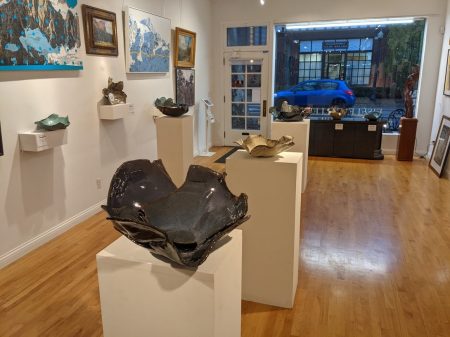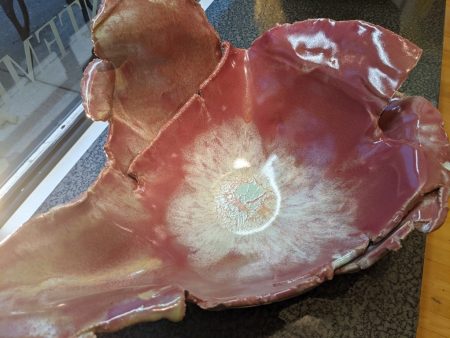
Image courtesy Aaron Kent.
Ceramic arts often conjure notions of utility or delicacy. In the museum, pottery fragments from ancient societies shed light on their domestic lives, and ornate porcelain objects speak to opulence of periods of wealth. Contemporary ceramic artists might play with these assumptions but also frequently eschew them to explore more sculptural concerns. A selection of recent bowls by Aaron Kent currently on view at the Eisele Gallery in Mariemont rejects the explicit function and refinement that tie ceramics to the anthropological, appearing instead as primordial or post-apocalyptic. Paradoxically, in exploring the rough and at times unpredictable physical properties of clay and glaze under the strain of gravity and fire, these bowls invite the same kind of sensuous visual and textural delights as their prim and proper counterparts.

Image courtesy Aaron Kent.
What Kent calls his “free form bowls” are initially made upside down. One or two roughly cut clay slabs sit atop a simple convex mold so that their sides droop and fall to form a rough but very imperfect bowl. Once dried, generous layers of glaze coat the bowls, pooling and swirling in unpredictable ways as they settle in to the craggy and deceptively complex surfaces. When fired, a kind of alchemy happens that reveals new colors and textures. Though striking from afar, hints of undercoats and splashes of color reveal themselves only to the close, attentive observer.

Detail photograph by author.
Looking into the bowls becomes a visual journey akin to reading tea leaves, staring into the eddies of a stream, or viewing a miniature Abstract Expressionist painting. When I first encountered them at the opening, I was repeatedly drawn inward, to the parts of the bowl that would usually be obscured by what it holds. Bending over these forms and tracing their delicate layers of color, I began to agree with Kent that these pieces work best as sculptural objects or empty centerpieces rather than as containers for fruit or bread (though the artist allows that buyers can do what they wish and has made them food grade, though obviously not dishwasher safe).

Image courtesy Aaron Kent.
Of course, the expressive manipulation of glazes and even the celebration of the flaw is nothing new to the world of ceramics. In Japanese aesthetics, the term wabi-sabi refers to the beauty in imperfection and transience, something expressed in some of the most revered pieces of pottery in art history. Together with practices from folk art, wabi-sabi aesthetics have inspired ceramicists all over the world for generations, to the point where even souvenir shops hock “one-of-a-kind” handmade mugs with dripping glazes and deliberate imperfections. Kent’s forms most certainly extoll the beauty in the imperfect but seem to take this to the extreme, not only in their jagged edges and rough-and-ready, semi-functional shapes but in their near total surrender to forces of nature. Gravity and heat take on expressive function—not as something to be harnessed by or contrasted with the control of the artist’s hand, but as elemental forces to be unleashed.
At Eisele Gallery, Kent’s free form bowls are nestled amidst more representational and pictorial objects and are just the most recent entry in a series of exhibitions by contemporary artists to take over the front of the storefront space in the heart of Mariemont. Deeper in gallery are salon-style walls featuring a variety of traditional genre, portrait, and landscape paintings by some of Cincinnati’s most famous artists, primarily from the nineteenth and early twentieth centuries, mixed in with a handful of lesser-known mid-century abstract painters and a smattering of local contemporary artists. One of Casey Riordan’s signature Shark Girl figures, for example, stands against the back wall peering out across the space. These short exhibitions up front enliven the space and complement the gallery’s bread-and-butter business with exhibitions that speak to different audiences and invite a new generation of collectors.
Kent has an active practice as a screen printer, running the silkscreen co-op DIY Printing, as well as a background in bronze casting, a process that is physically arduous and not without danger. The free form bowls command space (both in the kiln and on the table) and have jagged edges that simultaneously entice and repel touch. Kent’s relatively recent venture into ceramics began as an activity he undertook with his mother late in her life. Eisele’s press release suggests the works in the show, all produced after Kent’s mother passed away in 2019 from cancer, are a form of healing and honoring her memory. Unlike some of Kent’s other ceramic practice, these bowls reject the regularity of the potter’s wheel and the patient and contemplative process of wheel throwing. This could be read as akin to grief, something direct and viscerally felt that is at once raw and complex, sharp and delicate.
Eisele Gallery in Mariemont, November 12-27, 2021.
–Annie Dell’Aria



